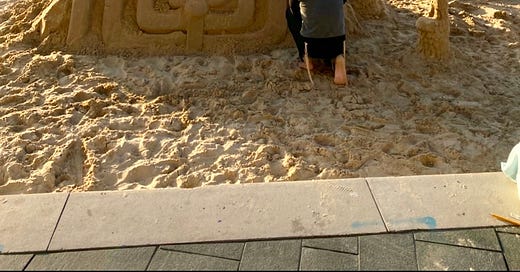Friends, so many of you have joined me as subscribers in the past week, motivated by an intense admiration for my prose, or an intense dislike of David Brooks (to judge from my inbox, something way beyond anything I feel), or a shared interest in corduroy. I promise that in the new year I will leave Brooks behind and say more about my real interests: the American religious scene, Friendly’s restaurants, the superiority of people who hail from the 413 area code, cold coffee, hot yoga, punctuation, and, yes, corduroy. There may also be posts on the late theologian Michael Wyschogrod’s essay “Letter to a Friend,” which one correspondent of mine said was the better version of what I was trying to say to David Brooks. Meanwhile, in the spirit of this season, here is an excerpt from my Wall Street Journal piece that ran today under the headline, “Make Hanukkah Bright, But Do It Right”:
Every year, there are those who urge their fellow Jews to put Hanukkah in its place: Keep presents small, emphasize the holiday’s distinctive Jewish character (it celebrates a second-century uprising against Greek overlords who wanted Jews to assimilate), and try not to let it be “Christmas Jr.,” materialistic and showy. This year that’s an especially tall order, since the first of Hanukkah’s eight nights began at sundown on Christmas Day.
I sympathize with this effort to tone down Hanukkah, especially the gift-giving. God save us, too, from the inflatable lawn displays—an innovation our non-Jewish neighbors might have spared us. But I would like to push back. Hanukkah, though liturgically a minor holiday, is a big deal. It isn’t a party holiday; nor is it concerned with the world to come. Rather, it’s a holiday that poses a unique question: How are Jews to relate to the non-Jewish world?
From the beginning, the sages emphasized that one of the most important aspects of Hanukkah was pirsumei nisa, “publicizing the miracle.” In other words, it isn’t enough to light candles in a hanukkiah, a special Menorah, to commemorate the miracle: that the jug of oil, found in the Jews’ defiled temple, burned for eight days, despite having enough oil for only one. One must also display the hanukkiah so that people outside can see the candles burn. With this display, this publicizing of the miracle, Jews not only identify themselves as Jews but bear witness to their relationship to God and history.
In Christian lands, such a public display historically took tremendous courage. Yet the Jewish tradition is unambiguous about its importance. “It is a mitzvah”—a commandment, or good deed—“to place the Hanukkah lamp at the entrance to one’s house on the outside, so that all can see it,” says the Talmud, the sixth-century compilation of Jewish teachings. If one forgets to light candles at sunset, that’s OK, according to the 16th-century Sephardic sage Joseph Karo in his code of Jewish law. “He should go ahead and light until people stop passing through the marketplace, which is approximately half an hour,” Karo wrote, “because then the people are passing and coming home and thus the miracle is publicized.”
What about Jews who can’t afford ground-floor dwellings, or who don’t own shops or houses? The Talmud doesn’t exempt them from the work of publicizing the miracle. A man who “lives upstairs . . . places it at the window adjacent to the public domain.”
What about Jews even poorer than the apartment dwellers—beggars or the homeless, who might struggle to get money for oil? The commandment still applies. “Even a poor man living off charity must lend or sell his clothes, and buy oil to kindle with,” Karo wrote. Better to be naked and celebrate Hanukkah than to be a clothed apostate.
The rest is here.




